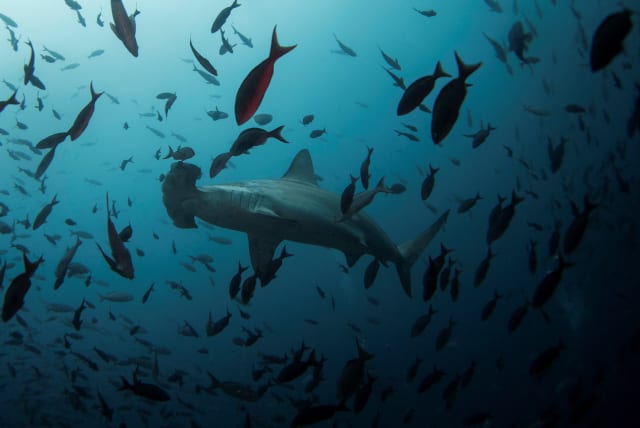Don't hold your breath: How hammerheads maintain temperature - study

Shark gills can act as natural radiators, cooling down the blood, muscles and organs of a shark.
Scalloped hammerhead sharks, also known as Sphyrna lewini, are able to close their gills when they dive for prey. This unique skill evolved to enable the shark to maintain its body temperature in cold waters.
A new peer-reviewed study, published in the journal Science, has unlocked the hammerhead's secret to successful survival in harsh conditions.
Scalloped hammerhead sharks are considered endangered in most parts of the world. Their population numbers have dwindled as a result of both commercial fishing and the shark fin trade, according to the National Oceanic and Atmospheric Administration (NOAA.)
According to the NOAA, the shark's natural lifespan is 30 years and they are able to grow up to 11 feet and weigh as much as 335 lbs.
New information on shark gills
Shark gills can act as natural radiators, cooling down the blood, muscles and organs. Without the ability to close the gills, sharks would become too cold during their deep sea dives for food.
“It was unexpected for sharks to hold their breath to hunt like a diving marine mammal. It is an extraordinary behavior from an incredible animal,” Mark Royer, lead author and researcher with the Shark Research Group at the Hawai‘i Institute of Marine Biology in the UH Mānoa School of Ocean and Earth Science and Technology told University of Hawai'i News.
“Although it is obvious that air-breathing marine mammals hold their breath while diving, we did not expect to see sharks exhibiting similar behavior,” said Royer. “This previously unobserved behavior reveals that scalloped hammerhead sharks have feeding strategies that are broadly similar to those of some marine mammals, like pilot whales. Both have evolved to exploit deep-dwelling prey and do so by holding their breath to access these physically challenging environments for short periods.”
How was this information discovered?
The research team discovered this unexpected find while equipping the sharks with devices designed to measure important information like their muscle temperature, the depth they dive to, their body orientation and activity levels.
Scientists were surprised to discover that the sharks were able to maintain muscle temperature during dives in water only a few degrees above freezing.
With this new information, scientists used deep-sea modeling to understand how the sharks were able to do this. It was here that they discovered the gills’ ability.
To further evidence this, scientists were able to recover footage of sharks swimming along the seabed at 3400 feet below sea level. In the footage, the sharks’ gill slits were closed. Footage from above the water showed that the gills had been opened but their temperature had lowered. This meant that the sharks held their breaths while diving.
“Holding their breath keeps scalloped hammerhead sharks warm but also shuts off their oxygen supply,” said Royer. “So, although these sharks hold their breath for an average of 17 minutes, they only spend an average of four minutes at the bottom of their dives at extreme depths before quickly returning to warmer, well-oxygenated surface waters where breathing resumes.”
“This discovery fundamentally advances our understanding of how scalloped hammerhead sharks are able to dive to great depths and withstand frigid temperatures in order to capture prey,” said Royer. “It also demonstrates the delicate physiological balance that scalloped hammerhead sharks must strike in order to forage successfully.”
“This new and detailed understanding of scalloped hammerhead physiology and ecology enhances our ability to effectively manage and conserve this iconic species by revealing potential vulnerabilities associated with changing ocean conditions or future human exploitation of these deep foraging habitats, such as deep-sea mining or large-scale fishing in the mesopelagic “twilight zone”, both of which might make it harder or more dangerous for these sharks to hunt their natural prey,” concluded Royer. “This extraordinary physiological feat that allows scalloped hammerhead sharks to expand their ecological niche into the deep sea could very well make them vulnerable to additional human impacts.”
Jerusalem Post Store
`; document.getElementById("linkPremium").innerHTML = cont; var divWithLink = document.getElementById("premium-link"); if (divWithLink !== null && divWithLink !== 'undefined') { divWithLink.style.border = "solid 1px #cb0f3e"; divWithLink.style.textAlign = "center"; divWithLink.style.marginBottom = "15px"; divWithLink.style.marginTop = "15px"; divWithLink.style.width = "100%"; divWithLink.style.backgroundColor = "#122952"; divWithLink.style.color = "#ffffff"; divWithLink.style.lineHeight = "1.5"; } } (function (v, i) { });

